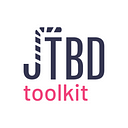How to Formulate Job Statements
JTBD is a language for describing people’s objectives and desired outcomes independent of any technology, solution, or brand. And like any language, there are rules. It’s the grammar and syntax of JTBD that allow you to provide clarity from otherwise irregular feedback from the individuals in your domain.
Before getting starting with the rules, it’s important to remember that the JTBD vernacular separates job statements (objectives) from the measures of success for getting a job done (outcomes). Think of the job as a functional goal. The outcomes reflect how well it was performed.
This article describes rules and patterns for formulating job statements for the main job or for job steps. We’ll look at the rules for formulating outcome statements in a subsequent post.
Consistency is Key
The precision that JTBD work brings with it comes from consistency. JTBD allows you to breakdown feedback from people in your markets into building blocks. Then, you can build models — like a job map or value proposition or job stories — from these small, consistent units of analysis.
At the highest level, job statements follow this simple pattern:
verb + object + clarifier
Examples include: visit family on special occasions, remove snow from pathways, listen to music on a run, and plan long-term financial well-being.
It’s also possible to include examples after a job statement. Use the abbreviation “e.g.” to add some specific instances that are representative of the types of jobs you’re describing. For instance, you could qualify a job visit family on special occasions with e.g., a birthday, graduation, or a holiday.
It’s worth noting the job statements are always formulated from the job performer’s perspective. In other words, the job to be done is not your job as a solution provider, it’s the individual’s job.
You can also see from the above examples that it’s possible to limit the scope of a job by adding circumstantial clarifies. For instance, you could decide to target a simple job, like get energy. But that’s perhaps too broad. Qualifying it to get energy in the morning is more specific.
Alternatively, you might decide to focus on how people get energy in the afternoon or even get energy in the afternoon at work. The phrases “in the afternoon” and “at work” are circumstances that to intentionally constrain your field of inquiry.
Finally, job statements avoid compound topics. If you have ANDs and ORs in your statement, one of two things is happening. Either you have synonyms and you should pick one or the other. Or, you have two separate ideas that should be treated individually. JTBD is a filter for normalizing insights about people into atomic building blocks that you combine into models to find opportunities.
Follow the Rules
Following the rules will help you create a stable and robust picture of the people you serve that your team can use.
To summarize, here are the key rules of formulating job statements:

Let’s look at how applying these rules might play out.
Below is a table with raw insights you might have gathered from research on the left. The middle column shows the problem that goes against the rules of job statements. In the last column is a corrected version following the guidelines.

Practice Makes Perfect
Like learning any language, formulating job statements takes practice. It’s a craft that is part science and part art. Try taking a simple job in your everyday life, like prepare a meal or commute to work, and formulate job steps following the rules, above.
One trick is to think of a silent “I want to…” in front of each statement that then gets omitted. This will help you formulate statements from the individual’s perspective. But don’t include phrases like “help me…” at the front of the job statement. Instead, begin directly with a verb.
Formulate jobs in a way that reflects a process. There needs to be a beginning, middle, and end. This is particularly important for your main job. In order to be able to create a job map, the main job needs to be formulated in a way to indicates a process.
The “done” part of jobs to be done is perhaps most important. A simple test of a job statement is to reverse the order of the statement to see if it makes sense and to see if there is a “done” state. For instance, if the job is to control daily spending, you can ask “Was daily spending controlled.”
To contrast, a job statement like manage finances is more problematic because “manage” more of an ongoing task that doesn’t have a clear end state. Asking “Were finances managed” results in a less conclusive answer to having an end state.
As you can see, words matter in JTBD work. Using a thesaurus is recommended. Always be on the lookout for the most compact and direct way to express a given job with words. Good job statements use strong verbs. It’s OK to start a job statement with verbs like “get” and “keep” and “be.” But statements that use words like “determine,” “complete,” or “locate” are better.
In the end, creating job statements is iterative. You’ll go through many cycles of refinement to get to well-formed job statements from your raw observations and insights. This is normal, so don’t get discouraged. With some practice, you’ll be able to see the world in terms of JTBD.
